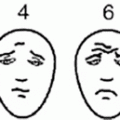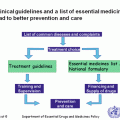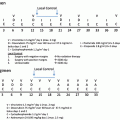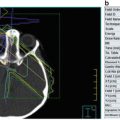Diagnosis
Location
Standard treatment
Options
Outcome in high-income countries
Prognostic factors
Low-grade glioma in surgical areas
All sites
Surgery
None
Excellent (95–100 % survival)
Extent of resection
Unresectable low-grade glioma
Optic pathways hypothalamus other sites may include thalamus, brainstem, and spinal cord. Disseminated low-grade gliomas
Chemotherapy (children <10)
– Conformal radiation in younger children
– Age (more aggressive in children under the age of 1)
Chemotherapy or Radiation (children >10)
– Chemotherapy as a first option regardless of age
85–90 % at 10 years
– Response to chemotherapy
– NF (better prognosis)
Ependymoma
All sites
Surgery + focal radiation
– Chemotherapy to delay irradiation in young children
70 % at 5 years in case of complete resection (30 % if resection is incomplete)
– Extent of resection
– Chemotherapy + second look surgery before radiation in the case of incomplete resection
Diffuse brainstem glioma
Brainstem
Focal radiation
Innovative approaches in addition to radiation
Poor. Median survival time: 9 months
– Younger age (less than 4 or 3 years old) is associated with longer survival time
Medulloblastoma in children >3 years old
Posterior fossa
Surgery + craniospinal irradiation + chemotherapy
– Concomitant chemo-radiotherapy (high risk patients)
50–80 %
– Extent of disease (metastasis)
– High dose chemotherapy following radiation (high risk patients)
– Extent of resections
– Reduced dose irradiation (average risk patients)
Medulloblastoma in infants and children <3 years old
Posterior fossa
Surgery followed by chemotherapy without radiation
– Chemotherapy followed by delayed irradiation
20–40 %
– Extent of disease
– Chemotherapy and focal irradiation (average risk patients)
– Extent of resection
– High dose chemotherapy ± radiation
– Nodular (desmoplastic histology, associated with excellent outcome with post-operative chemotherapy only, no radiation)
High-grade glioma
All sites
Surgery + focal radiation + chemotherapy
– Concomitant chemo and radiotherapy
20–40 %
– Extent of resection
– P53 status (poor outcome if positive)
Germ cell tumours (germinoma)
Suprasellar-pineal
Surgery (biopsy) + chemotherapy + radiation (ventricular)
Craniospinal radiation only
90–95 %
– None
Germ cell tumours (non-germinomatous germ cell tumours)
Suprasellar-pineal
Surgery (optional: diagnosis can be done on markers—HCG and AFP). Chemotherapy + focal or craniospinal radiation
High dose chemotherapy in poor responders to treatment
70 %
– Response to treatment
The diversity of paediatric brain tumours is huge and there are no formal guidelines for the management of these tumours in countries with limited resources. A working group in the International Society of Paediatric Oncology is currently developing guidelines for the management of paediatric brain tumours in countries with limited resources. However, the management is primarily dependent on the resources available locally, in particular in terms of neurosurgical and radiation oncology equipments and this will significantly influence the application of these proposed recommendations.
1.
Low-grade gliomas
Low-grade gliomas are the most common brain tumour in the paediatric age group. Most paediatric low-grade gliomas are pilocytic (grade 1). In this category, cerebellar astrocytomas are the prototype of the so-called surgical tumours and complete resection is curative. When resection is incomplete, a wait and watch approach is recommended and repeat surgery is only performed in case of progression of residual tumour [39].
When the tumour is located in an unresectable location such as the optic pathway or the brainstem (although a subset of these tumour are amenable to complete or subtotal resection), non-surgical treatment may be considered, based on the risk associated with tumour progression. Chemotherapy is the treatment of choice, with several potential options [37]. The combination of vincristine and carboplatin is a standard regimen worldwide [40]; however, other protocols have shown benefit (such as TPCV—a combination of thioguanine, procarbazine, lomustine and vincristine [41]—the etoposide-cisplatin [42] combination, or single agent vinblastine [43] or vinorelbine [44] amongst others). The response rate to chemotherapy varies from 30 to 70 %. However, most children will eventually show progression and will require further treatment. Recent reports have suggested that multiple lines of chemotherapy allow avoidance of radiation [45]. Still, the management of children with unresectable low-grade gliomas is challenging and the respective role of chemotherapy and focal radiation is currently unsettled, particularly in children who show progression after a first line of chemotherapy.
2.
Medulloblastoma
Most common malignant brain tumour in the paediatric age group, medulloblastoma is often not diagnosed in countries with limited resources, as children essentially succumb before diagnosis. When the tumour is identified on imaging, treatment should ideally include surgery followed by craniospinal radiation and chemotherapy, depending of the resources available. Ideally patients should have a complete preoperative staging prior to surgery, including MRI scan of the brain and the spine. If this radiological assessment does not show evidence of dissemination, maximum resection should be attempted, as extent of resection has a significant impact on survival [22]. In children with disseminated disease, the impact of resection is less obvious. Radiation should include the craniospinal axis with a boost to the posterior fossa or the tumour bed. The dose to the posterior fossa depends on the initial staging: children with no evidence of dissemination (no evidence of metastatic disease on initial imaging, and no evidence of CSF involvement on CSF cytology performed at least 10 days after surgical resection), the recommendation is a dose f 23.4 Gy to the craniospinal axis in 13 fractions and a posterior fossa or (better) a tumour bed boost of 30.6 Gy is recommended [29]. For patients with incomplete resection (residue >1.5 cm in diameter) or patients with metastatic disease, a dose of 36 Gy in 20 fractions with a boost of 18 Gy to the posterior fossa/tumour bed is recommended [46]. Numerous chemotherapy protocols could be used. The current template used by the SIOP committee is a combination of etoposide and cisplatin for three courses, followed by a combination of cyclophospamide and vincristine for three courses.
3.
Ependymoma
Ependymoma accounts for around 10 % of paediatric CNS tumours. More than 90 % occur in the brain; two thirds of them in the posterior fossa [23]. Clinical presentation depends on the site of the tumour.
The histological grading of ependymoma and its correlation with outcome is still a matter of controversies. So far, the treatment of ependymoma is essentially identical, regardless of the histological grading (i.e. grade 2 or grade 3). The most widely accepted prognostic factor is the degree of surgical resection with complete resection associated with a better prognosis (70–80 % overall survival) at 5 years with gross total resection compared to 30 % with subtotal/partial resection [38]. Therefore the role of the surgeons is critical and second look surgery is recommended in case of incomplete resection. The role of chemotherapy is still unclear in this disease [47]. There is some suggestion that chemotherapy may facilitate a second resection when residual tumour is present after initial resection. In any case, radiation is a critical component of the post-operative treatment. Modern techniques of radiation allow the delivery of high dose radiation in small volumes without significant impact on neurocognitive outcome. In this context, current protocols in high-income countries consider focal radiation at a dose of 54–59.4 Gy in 1.8 G fractions since the age of 1 [30]. When conformal or stereotactic radiation is not available, chemotherapy may be an alternative in infants and young children under the age of 3 [48, 49]. However, the results of a post-operative chemotherapy-only approach are essentially disappointing.
Guidelines regarding the management of other tumour types are provided in Table 25.1. However, these are essentially based on the experience reported in high-income countries. The relevance and the feasibility of these recommendations in countries with limited resources remain to be demonstrated.
Treatment Side Effects
During the course of treatment, children with brain tumours are prone to many challenges whether related to their original disease or to the applied treatment protocols. They may require physical and occupational rehabilitation, mental and psychosocial support and reintegration programs in schools and community to allow them to be functionally productive in the future. When present, visual impairment as well as hearing deficits needs to be assessed, and patients should be directed to specific facilities that will help them to deal with these handicaps. These are generally not a priority in low-income countries and physicians should be aware that the use of ototoxic medications, for example, can lead to irreversible hearing loss and the need of usually unaffordable correcting devises.
Many children will also need hormonal supplementation after brain irradiation [50]. Availability of regular endocrine testing and daily administration of hormone replacement, like growth hormone, may be challenging in countries with limited resources. In reality, most children with CNS tumours are very early lost to follow-up in countries with limited resources. A recent international survey showed that the number of aftercare program in countries with limited resources was limited [51]. It is clear that well-designed programs for assessment of aftercare morbidities are difficult to implement in this context.
Palliative Care
Owing to the delayed diagnosis, many children with brain tumour diagnosed in countries with limited resources present with advanced disease and very often in this context, supportive care and palliative treatment would be the most appropriate option. In addition, a number of paediatric brain tumours have a poor prognosis, such as high-grade glioma, DIPG or atypical teratoid rhabdoid tumours. It is expected that in such context, a majority of patients will eventually succumb to their disease. Pain control and proper palliative care interventions would be important at this stage. Low-income countries are particularly lacking such services [52, 53] and families often perceive palliative care as an abandonment of treatment. Other issues are critical such as access to appropriate pain medications. There is an obvious need to develop palliative care guidelines that address the need of the paediatric brain tumour population in these countries and that also take into account local or regional specificities, in particular social, cultural or religious contexts. A recent work conducted in families of children diagnosed with DIPG in Jordan suggested that it is possible to address palliative care issues at an early stage and this approach can facilitate the implementation of end of life decisions [54].
Twinning Programs
In the face of the many challenges associated with the management of childhood brain tumour in countries with limited resources, efforts have been developed to implement neuro-oncology programs through twinning initiatives. Such initiatives have shown success in the management of childhood leukemia and have demonstrated that proven treatment regimens can be adapted for use in countries with limited resources [55]. Although the multidisciplinary care in neuro-oncology requires specific attention, successful twinning initiatives have been described with significant impact on management and outcomes [56, 57].
Conclusion
The concept of paediatric neuro-oncology is still at its infancy in countries with limited resources. Appropriate neuro-imaging facilities, neurosurgical units, radiation equipment and paediatric oncology services are prerequisites for the implementation of such programs. A number of programs have been recently implemented, often in the context of twinning initiatives.
Stay updated, free articles. Join our Telegram channel

Full access? Get Clinical Tree







